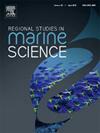Sediment fluxes and mechanisms in a macro-tidal turbid estuary during typhoon events
IF 2.1
4区 环境科学与生态学
Q3 ECOLOGY
引用次数: 0
Abstract
In turbid macro-tidal estuaries (MTE), typhoons interact with tides and high turbidity, significantly impacting the natural and social environments of the coastal zones. A tide-wave-sediment numerical model was built and validated for Hangzhou Bay (HZB), using reconstructed near-shore typhoon wind fields. The model incorporates wave-current coupling and water-sediment density coupling and considers fine sediment flocculation and fluid mud bottom boundary layer. Results show that the typhoon remarkably enhances wave-induced bottom stress but slightly increases current-induced bottom stress. Increased wave-induced bottom stress led to intensified sediment resuspension, subsequently increasing suspended sediment concentration (SSC) and SSF during the typhoon. Typhoon wind fields primarily impact sediment transport, with large wave impacts on both the south and north banks, while the effect of air pressure was negligible. The tide-induced net SSF was eastward. Residual currents magnitudes and SSC were positively correlated with typhoon intensity. Tide-surge nonlinear effects decrease the SSC. By decomposing the net SSF, the Euler transport term (T1) and the tidal trapping effect (T4) were the main terms among 7 components. The winds promoted sediment transport mainly through T1 and T4. For wave-induced sediment transport, T4 was the main term. The tide-surge nonlinear interaction suppressed surge-induced sediment transport through T1 and tide-induced sediment transport through T4. The findings reveal the mechanism of sediment transport during extreme weather conditions in macro-tidal turbid estuaries.
台风期间大潮混浊河口泥沙通量及其机制
在浑浊大潮河口(MTE),台风与潮汐和高浑浊度相互作用,对海岸带的自然环境和社会环境产生重大影响。利用重建的近岸台风风场,建立了杭州湾(HZB)的潮-波-沙数值模型并进行了验证。该模型考虑了波流耦合和水沙密度耦合,并考虑了细泥沙絮凝和流体泥浆底边界层。结果表明,台风显著增强了波浪引起的底应力,但轻微增加了水流引起的底应力。台风期间,波浪引起的底部应力增加导致泥沙再悬浮加剧,从而导致悬浮泥沙浓度(SSC)和SSF增加。台风风场主要影响输沙,南岸和北岸都有较大的波浪影响,气压的影响可以忽略不计。潮致净SSF向东。剩余海流大小和SSC与台风强度呈正相关。潮涌非线性效应降低了SSC。通过对净SSF的分解,欧拉输运项(T1)和潮汐捕获效应(T4)是7个分量中的主要项。风主要通过T1和T4促进输沙。对于波浪输沙,T4是主要项。潮-浪非线性相互作用抑制了T1段的潮输沙和T4段的潮输沙。研究结果揭示了大潮浑浊河口极端天气条件下泥沙输运的机制。
本文章由计算机程序翻译,如有差异,请以英文原文为准。
求助全文
约1分钟内获得全文
求助全文
来源期刊

Regional Studies in Marine Science
Agricultural and Biological Sciences-Ecology, Evolution, Behavior and Systematics
CiteScore
3.90
自引率
4.80%
发文量
336
审稿时长
69 days
期刊介绍:
REGIONAL STUDIES IN MARINE SCIENCE will publish scientifically sound papers on regional aspects of maritime and marine resources in estuaries, coastal zones, continental shelf, the seas and oceans.
 求助内容:
求助内容: 应助结果提醒方式:
应助结果提醒方式:


